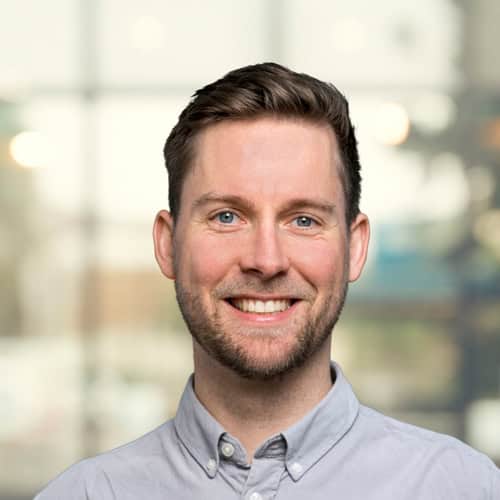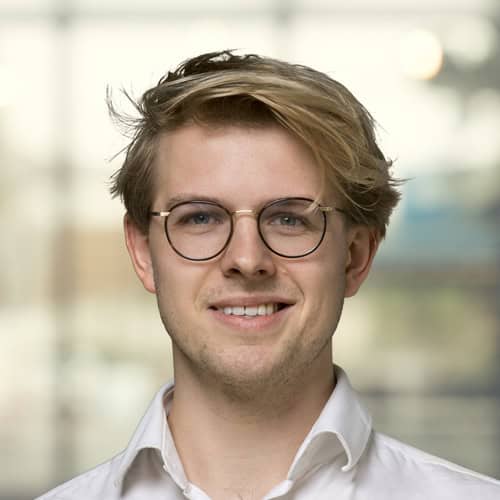
The Wadden Islands can already meet a significant part of their own demand for sustainable electricity by 2030, not only by large-scale generation of energy from wind and sun but also by smart use of the sea. That was the conclusion of the TNO report that the Wadden Fund presented earlier this year to outgoing Minister of Climate and Energy Rob Jetten.
Many media picked up the report, and the headlines were all raving. Researchers Sam Lamboo and Floris Taminiau, who wrote the report, emphasize that the study figures only represent the theoretical potential. Taminiau: “To generate 83% of the energy ourselves in 2030, there are a lot of practical obstacles to overcome.”

About Sam Lamboo
Sam Lamboo has worked at TNO for over six years and has a broad background in sustainability research. He studied at the University of Twente and specialized in sustainable energy technology. His role at TNO is multifaceted, ranging from researcher and project leader to consultant, with a strong emphasis on applied research for policy. Two years ago, Sam conducted a major study on energy and water on a national scale, which formed the basis for the current study.

About Floris Taminiau
Floris Taminiau joined TNO in 2019 and gained experience in several departments, including wind energy and energy transition studies. His interests lie in investigating industrial decarbonization, the EU ETS, local energy exchange systems, and lifestyle change for emission reduction. He studied physics at the University of Amsterdam, with a focus on renewable energy and nanophotonics.
The research
The Wadden Fund approached TNO with the request to independently test three technologies for energy generation from water (EuW: Energy from Water): wave energy, tidal energy, and energy from the voltage difference between fresh water and saltwater.
Lamboo: “We spoke with the Wadden Fund and companies developing EuW technologies. In all parties, we saw very clearly a kind of pride and commitment to water. It fits well with the identity of the Wadden to generate its energy with water. At the same time, there is also a strong sense of protection for nature. The priority in this region is very clearly on nature.”
Taminiau: “That brings us to one of the report’s main conclusions. Specific ecological research is necessary to understand the impact of different techniques on the Wadden area.” The advice is to look carefully at the sites and their ecological effects, such as the impact of brackish water discharges (due to energy from the difference in salinity) on flora and fauna.
The technologies
- Wave energy
- A wave energy converter extracts energy from the rapidly changing water level caused by passing waves. The technique for extracting the energy from waves can depend on the type of waves.
- Tidal energy
- Water flows to and from the coast under the influence of tides. In places with a geographical constriction—for example, between two islands—this water accelerates, and the current is often strong. Inflow turbines or underwater kites can extract energy from the flowing water.
- Energy from the difference in salinity
- This technique involves extracting energy from the difference in salinity of two bodies of water. Typically, fresh river water and salt seawater are used, but (industrial) wastewater with high salinity can also be used, such as brine.
The above capacities are far from the yields of wind and solar power, but there are many advantages. Lamboo: “These technologies fulfill a new profile. High waves are often present at a time different from wind or solar waves. Moreover, you can predict well months in advance from these technologies what you expect from the yield. That can be of great value to companies wanting to buy power at a specific time for a specific price.”
Moreover, the researchers saw that many companies involved use the Wadden region as a springboard. Many of them plan to exploit their technology in other countries. “Globally, there is a lot of potential for this kind of technology,” Taminiau said.
What can we learn from the sea? What role can the ocean play in generating renewable energy? And how can innovations help us take better care of the sea? Find out in our newest edition: IO Next: The Ocean.

Challenges
Grid congestion, ecological effects, and required space for the plants generating energy from water are three of the main obstacles to an energy-independent Wadden area in the future. “The challenge lies first of all in the development of technology. In addition, the use of space is a difficult issue. The entire Wadden Sea and much of the coast outside the Wadden Islands fall under Natura 2000 guidelines and are thus protected. Windmills, military zones, sand extraction, fishing, drilling platforms, and shipping are busy at sea. Our research shows that in theory, there is enough space to place new EuW installations, but choices about how we want to use the space at sea – and what ecological impact that will have – have yet to be made,” Lamboo explains.
Then, the next problem they can’t avoid on the Wadden Islands is grid congestion. There needs to be more room on the grid for large-scale energy projects. On the map of Netbeheer Nederland, all islands are colored red, and only Texel is half orange.
“Extensions are being made,” Taminiau knows, “but they take a long time, and developers have big ambitions in the short term. Also, when there are connections, there is often a waiting list. Now that the waiting list works on a first-come, first-served basis. Network operators are working on that, though. It would be nice if projects that do not burden the grid could be given priority, for example, if EuW installations cooperate with storage projects.”
The Wadden region can become an example of sustainable transition through technical innovation and ecological responsibility. Becoming completely independent is a lovely, ambitious goal, but not necessarily the most efficient. Lamboo: “Our advice is to optimize with available options and not stare blindly at wanting to do everything yourself. If the islands generate 80% of the energy and get the rest from the mainland via a cable, that’s already super.


